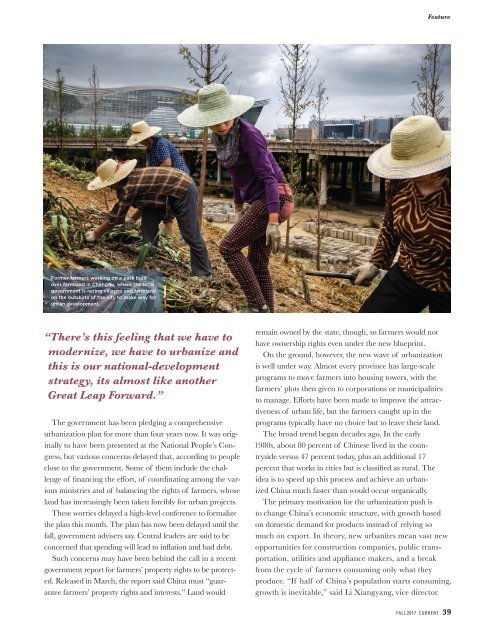Current Magazine
Create successful ePaper yourself
Turn your PDF publications into a flip-book with our unique Google optimized e-Paper software.
Feature<br />
Former farmers working on a park built<br />
over farmland in Chengdu, where the local<br />
government is razing villages and farmland<br />
on the outskirts of the city to make way for<br />
urban development.<br />
“There’s this feeling that we have to<br />
modernize, we have to urbanize and<br />
this is our national-development<br />
strategy, its almost like another<br />
Great Leap Forward.”<br />
The government has been pledging a comprehensive<br />
urbanization plan for more than four years now. It was originally<br />
to have been presented at the National People’s Congress,<br />
but various concerns delayed that, according to people<br />
close to the government. Some of them include the challenge<br />
of financing the effort, of coordinating among the various<br />
ministries and of balancing the rights of farmers, whose<br />
land has increasingly been taken forcibly for urban projects.<br />
These worries delayed a high-level conference to formalize<br />
the plan this month. The plan has now been delayed until the<br />
fall, government advisers say. Central leaders are said to be<br />
concerned that spending will lead to inflation and bad debt.<br />
Such concerns may have been behind the call in a recent<br />
government report for farmers’ property rights to be protected.<br />
Released in March, the report said China must “guarantee<br />
farmers’ property rights and interests.” Land would<br />
remain owned by the state, though, so farmers would not<br />
have ownership rights even under the new blueprint.<br />
On the ground, however, the new wave of urbanization<br />
is well under way. Almost every province has large-scale<br />
programs to move farmers into housing towers, with the<br />
farmers’ plots then given to corporations or municipalities<br />
to manage. Efforts have been made to improve the attractiveness<br />
of urban life, but the farmers caught up in the<br />
programs typically have no choice but to leave their land.<br />
The broad trend began decades ago. In the early<br />
1980s, about 80 percent of Chinese lived in the countryside<br />
versus 47 percent today, plus an additional 17<br />
percent that works in cities but is classified as rural. The<br />
idea is to speed up this process and achieve an urbanized<br />
China much faster than would occur organically.<br />
The primary motivation for the urbanization push is<br />
to change China’s economic structure, with growth based<br />
on domestic demand for products instead of relying so<br />
much on export. In theory, new urbanites mean vast new<br />
opportunities for construction companies, public transportation,<br />
utilities and appliance makers, and a break<br />
from the cycle of farmers consuming only what they<br />
produce. “If half of China’s population starts consuming,<br />
growth is inevitable,” said Li Xiangyang, vice director<br />
FALL 2017 CURRENT 39





